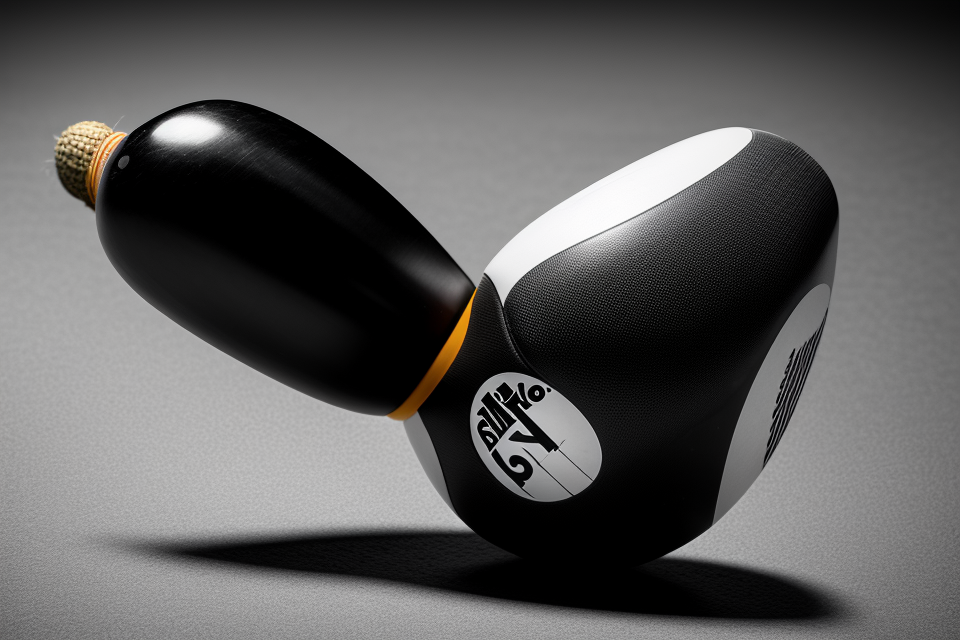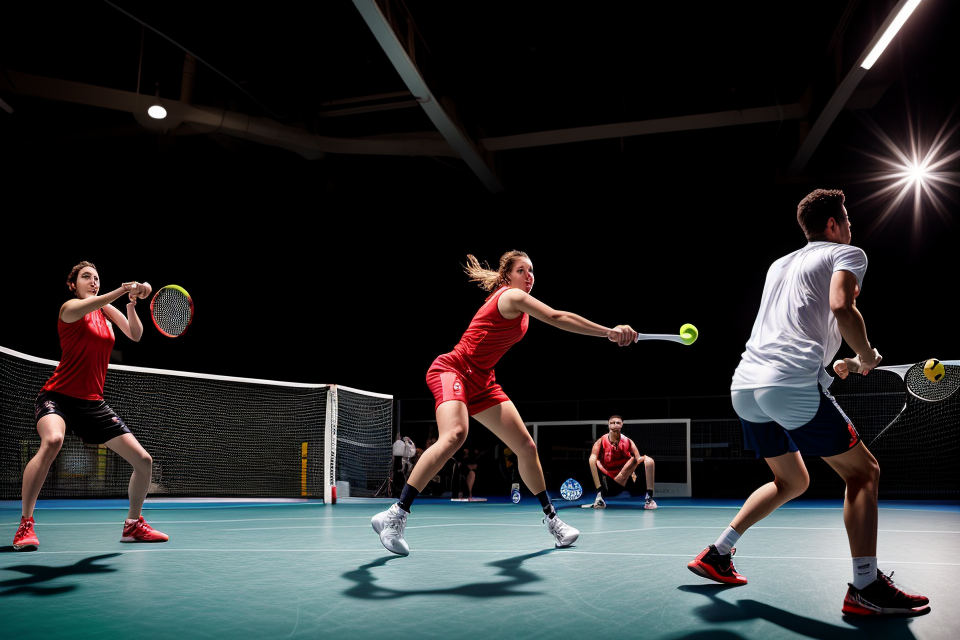Are you tired of hitting weak shots in squash? Do you want to unleash the power within you and take your game to the next level? Look no further! This article will provide you with expert tips and techniques to help you maximize power in your squash swings. Whether you’re a beginner or an experienced player, these tips will give you the edge you need to dominate the court. Get ready to learn how to hit with confidence and precision, and intimidate your opponents with your powerful shots. So, grip your racquet tight, and let’s get started!
Understanding the Importance of Power in Squash
The Role of Power in Squash Matches
In squash, power plays a crucial role in determining the outcome of matches. A player who can generate power in their swings has a significant advantage over their opponent, as they are able to hit the ball with greater force and accuracy. This power can be used to attack the opponent’s weaknesses, set up winners, and control the pace of the game.
However, simply relying on power alone is not enough to be successful in squash. Players must also have good technique, strategic thinking, and the ability to adapt to their opponent’s style of play. Power is just one aspect of the game, and it must be used in conjunction with other skills to achieve success.
Additionally, players must also be mindful of their physical conditioning and fitness level. Power requires a combination of strength, speed, and endurance, and players who are physically fit are better able to generate power in their swings and sustain it throughout the match. Therefore, it is important for players to incorporate strength and conditioning exercises into their training regimen to improve their power on the court.
How Power Affects Your Performance on the Court
- Increased Speed and Accuracy:
- A powerful swing allows for more velocity behind the ball, leading to faster and more accurate shots.
- This can be especially crucial in professional squash matches, where small differences in speed and accuracy can make a significant impact on the outcome of the game.
- Better Control and Placement:
- With increased power comes improved control over the ball, enabling players to place their shots more precisely on the court.
- This is essential for executing strategic shots and setting up plays, as it allows players to manipulate the pace and direction of the ball to their advantage.
- Enhanced Defense and Offense:
- A powerful swing also helps in defense, as it enables players to hit the ball with more force, making it more difficult for opponents to return.
- Offensively, a powerful swing can help players maintain control of the rally and put pressure on their opponents, forcing them to make errors or retreat.
- Reduced Fatigue and Injury Risk:
- A properly executed powerful swing can help reduce the strain on the player’s body, as it requires less effort and energy compared to a weak or unbalanced swing.
- This can help prevent fatigue and injury, allowing players to maintain their performance levels throughout the match.
- Overall Match Dominance:
- A player with a powerful swing has a significant advantage over their opponents, as they can consistently hit winners and force errors from their opponents.
- This can lead to a higher winning percentage and a greater likelihood of success on the court.
Improving Your Squash Power: Warm-Up and Stretching Techniques
Pre-Match Warm-Up Routine
Before stepping onto the squash court, it is essential to have a proper pre-match warm-up routine to prepare your body for the physical demands of the game. A well-planned warm-up routine can help you avoid injuries, improve your performance, and enhance your power on the court. Here are some expert tips on how to create an effective pre-match warm-up routine:
1. Cardiovascular Warm-Up
Begin your warm-up routine with a cardiovascular warm-up to get your heart rate up and increase blood flow to your muscles. This can be achieved through light jogging, cycling, or rowing for 5-10 minutes. This will help to raise your core temperature, which will prepare your muscles for physical activity.
2. Dynamic Stretching
Dynamic stretching involves moving your joints through their full range of motion, which can help to increase flexibility and reduce the risk of injury. Some examples of dynamic stretches include leg swings, arm circles, and hip rotations. These stretches should be performed slowly and controlled, with a minimum of 3 sets of 10 repetitions for each stretch.
3. Muscle Activation Drills
Muscle activation drills involve contracting specific muscle groups to prepare them for the demands of the game. For example, you can perform leg presses, calf raises, and glute bridges to activate your lower body muscles. Similarly, you can perform scapular squeezes and shoulder presses to activate your upper body muscles. These drills should be performed with a slow and controlled movement, with a minimum of 3 sets of 10 repetitions for each drill.
4. Mobility Exercises
Mobility exercises are designed to improve your range of motion and reduce the risk of injury. Examples of mobility exercises include hip openers, spinal twists, and quad stretches. These exercises should be performed slowly and controlled, with a minimum of 3 sets of 10 repetitions for each exercise.
5. Activation of the Core
Finally, it is essential to activate your core muscles before stepping onto the court. Your core muscles are responsible for stabilizing your spine and transferring power from your lower body to your upper body. Some examples of core activation exercises include plank variations, bicycle crunches, and leg raises. These exercises should be performed with a slow and controlled movement, with a minimum of 3 sets of 10 repetitions for each exercise.
By incorporating these expert tips into your pre-match warm-up routine, you can improve your performance on the squash court and maximize your power on the court.
Dynamic Stretching for Squash Power
As a professional squash player, you understand the importance of power in your game. Whether you’re hitting a ball across the court or sprinting to your next position, power is essential to your success. One key aspect of improving your power is through dynamic stretching.
Dynamic stretching is a type of stretching that involves active movements, rather than static stretches that hold a position for a prolonged period. This type of stretching is particularly beneficial for athletes, as it helps to improve range of motion, increase blood flow, and enhance power.
To incorporate dynamic stretching into your warm-up routine, consider the following exercises:
- Leg swings: Stand with your feet shoulder-width apart and swing one leg forward and backward, keeping it straight. Repeat with the other leg.
- Arm circles: Stand with your feet shoulder-width apart and extend your arms out to the sides. Make small circles with your arms, gradually increasing the size of the circles.
- Hip circles: Stand with your feet shoulder-width apart and shift your weight onto one foot. Make small circles with your hips, gradually increasing the size of the circles.
- Jumping jacks: Stand with your feet together and your arms at your sides. Jump your feet out and raise your arms above your head, then jump back to starting position.
By incorporating these dynamic stretches into your warm-up routine, you can improve your power and reduce your risk of injury. Additionally, dynamic stretching can help to increase your flexibility and range of motion, allowing you to reach for the ball more easily and make powerful swings.
Improving Your Squash Power: Technique and Form
The Correct Grip on Your Racquet
A firm grip on your racquet is crucial to achieving maximum power in your squash swings. A loose grip can lead to a loss of control and power, while a grip that is too tight can cause tension and limit your ability to move freely.
To achieve the correct grip, follow these steps:
- Place your dominant hand on the handle of the racquet, with your palm facing down.
- Place your non-dominant hand on the handle, with your palms facing each other.
- Position your hands so that the knuckles of your dominant hand are aligned with the strings of the racquet.
- Tighten your grip slightly, but avoid squeezing too hard, which can cause tension in your hands and wrists.
It’s important to note that the grip should be comfortable and natural, and you should be able to move your wrists freely during your swing. If you find that your grip is causing discomfort or limiting your movement, it may be necessary to adjust it.
Additionally, it’s important to maintain a consistent grip throughout your swing, as a change in grip can cause a loss of control and power. Practice your grip regularly to ensure that it becomes second nature, and always be mindful of your grip when making adjustments during a match.
Proper Footwork for Powerful Swings
Proper footwork is crucial in generating power in your squash swings. Here are some tips to help you improve your footwork:
1. Start with the right stance
The first step in having proper footwork is to start with the right stance. Stand with your feet shoulder-width apart, with your dominant foot slightly in front of your non-dominant foot. This will give you a stable base from which to launch your swing.
2. Shuffle your feet
As you approach the ball, shuffle your feet into position. This means taking short, quick steps towards the ball, keeping your weight on your toes and your knees slightly bent. This will help you stay light on your feet and maintain balance and agility.
3. Explode off your back foot
When you’re ready to hit the ball, explode off your back foot, using your legs to generate power. Your dominant leg should be the one that you push off with, driving your hips and shoulders forward towards the ball.
4. Keep your weight forward
As you swing, keep your weight forward and over your toes. This will help you maintain balance and power, and prevent you from slowing down or losing momentum.
5. Pivot on your front foot
As you hit the ball, pivot on your front foot, turning your hips and shoulders towards the direction of the shot. This will give you added power and accuracy, and help you stay balanced and in control of your swing.
By following these tips, you can improve your footwork and generate more power in your squash swings. Remember to practice these techniques regularly, and focus on maintaining proper form and balance throughout your swing.
Using Your Non-Dominant Eye for Better Accuracy
When it comes to improving your squash power and accuracy, using your non-dominant eye can make a significant difference. Here’s how:
- Gaze: Focus your gaze on the point where you want to hit the ball.
- Eye Dominance: If you’re right-handed, your left eye may be dominant, and vice versa. It’s essential to identify which eye is dominant and use it for squash swings.
- Aim: Align your body, racquet, and eye towards the target to ensure proper aim.
- Balance: Maintain your balance and footwork while focusing on your non-dominant eye.
- Practice: Regularly practice using your non-dominant eye during squash swings to improve your accuracy and overall performance.
By incorporating these techniques into your squash swings, you can enhance your accuracy and overall performance on the court.
Increasing Your Squash Power: Training and Conditioning
Strength Training for Squash Power
When it comes to maximizing power in your squash swings, strength training is an essential component of your overall training regimen. Here are some expert tips and techniques to help you develop the muscle strength and power needed to excel on the squash court:
Resistance Training
One of the most effective ways to build muscle strength and power is through resistance training. This can include exercises such as weightlifting, resistance band workouts, and bodyweight exercises. By working against resistance, you can build the muscle strength needed to generate power in your squash swings.
Explosive Plyometrics
In addition to resistance training, explosive plyometrics can also be a valuable tool for building power in your squash swings. Plyometrics are exercises that involve quick, explosive movements, such as jumps and bounds. By incorporating plyometrics into your training regimen, you can develop the explosiveness and power needed to hit with precision and force on the squash court.
Functional Training
Functional training is another effective way to build muscle strength and power for squash. This type of training focuses on exercises that target the muscles used in squash movements, such as the legs, core, and upper body. By training these muscles in a functional way, you can improve your overall power and performance on the court.
Progressive Overload
To continue making progress and improving your power on the squash court, it’s important to gradually increase the intensity and difficulty of your strength training workouts over time. This is known as progressive overload, and it involves gradually increasing the weight, resistance, or reps of your exercises to challenge your muscles and help them adapt and grow.
By incorporating these strength training techniques into your training regimen, you can build the muscle strength and power needed to excel on the squash court and take your game to the next level.
Cardiovascular Conditioning for Squash Matches
As a squash player, cardiovascular conditioning is essential to ensure that you have the endurance and stamina needed to perform at your best during matches. Here are some tips for improving your cardiovascular fitness:
- Incorporate cardio exercises into your training routine: Cardio exercises such as running, cycling, or swimming can help improve your cardiovascular fitness. Aim to include at least one cardio session in your training routine per week, and gradually increase the intensity and duration of your workouts over time.
- Engage in high-intensity interval training (HIIT): HIIT involves short bursts of intense exercise followed by periods of rest. This type of training can be highly effective for improving cardiovascular fitness and has been shown to enhance endurance and power in squash players. Examples of HIIT workouts include sprint intervals, hill sprints, and plyometric drills.
- Include drills that mimic squash movements: Incorporating drills that mimic the movements and intensity of squash matches can help improve your cardiovascular fitness and endurance. For example, you can perform ladder drills, shuttle runs, or agility drills to improve your speed, agility, and stamina.
- Practice good nutrition and hydration: Proper nutrition and hydration are crucial for maintaining good cardiovascular health. Make sure to consume a balanced diet that includes plenty of fruits, vegetables, whole grains, and lean protein. Stay hydrated by drinking plenty of water before, during, and after exercise.
By incorporating these tips into your training routine, you can improve your cardiovascular fitness and perform at your best during squash matches.
Drills for Building Power and Speed
One of the most effective ways to improve your squash power is by incorporating specific drills into your training regimen. These drills are designed to help you build both power and speed, which are essential components of a successful squash player.
The Wall Drill
The wall drill is a popular exercise among squash players, as it helps to develop the muscles used in the swing motion. To perform this drill, stand about six feet away from a wall and make small, quick swings with your racquet, trying to hit the wall as many times as possible in a row. As you become more comfortable with the drill, you can gradually increase the number of swings and the distance from the wall.
The Rebound Drill
The rebound drill is another effective exercise for building power and speed. To perform this drill, stand with your back to a wall and make a full swing, hitting the ball off the wall and immediately transitioning into a follow-through. As you continue to swing, try to hit the ball with more power and speed, aiming to make contact with the ball at the highest point possible.
The Toss Drill
The toss drill is a great way to improve your ability to hit with power and accuracy. To perform this drill, toss the ball up and hit it with a full swing, aiming to make contact with the ball at the highest point possible. As you become more comfortable with the drill, try to hit the ball with more power and speed, while still maintaining accuracy.
The Shuffle Drill
The shuffle drill is a great way to improve your footwork and agility, which are crucial components of a successful squash player. To perform this drill, shuffle sideways with your racquet in hand, making small, quick swings as you move. As you become more comfortable with the drill, try to hit the ball with more power and speed, while still maintaining control and accuracy.
Incorporating these drills into your training regimen can help you build the power and speed needed to excel on the squash court. Remember to focus on proper technique and form, and gradually increase the intensity and difficulty of the drills as you become more comfortable and confident.
Incorporating Power Training into Your Squash Practice
Tracking Your Progress and Adjusting Your Training
As you incorporate power training into your squash practice, it’s important to track your progress and adjust your training accordingly. Here are some expert tips to help you do just that:
Using Performance Metrics to Measure Progress
One of the most effective ways to track your progress is by using performance metrics. These metrics can include your squash speed, power output, and ball speed, among others. By regularly measuring these metrics, you can get a better understanding of your strengths and weaknesses, and adjust your training accordingly.
Analyzing Video Footage of Your Swings
Another effective way to track your progress is by analyzing video footage of your swings. This can help you identify any technical flaws in your swing, such as poor body positioning or inconsistent timing. By analyzing your swings frame by frame, you can make adjustments to your technique and improve your power and accuracy on the court.
Listening to Your Body
It’s also important to listen to your body and adjust your training accordingly. If you’re feeling fatigued or experiencing pain, it may be a sign that you need to take a break or switch up your training routine. On the other hand, if you’re feeling energized and powerful on the court, it may be a sign that you’re on the right track and should continue pushing yourself.
Working with a Coach or Personal Trainer
Finally, working with a coach or personal trainer can be a great way to track your progress and adjust your training. A coach or trainer can provide expert feedback on your technique, suggest new exercises and drills to try, and help you develop a personalized training plan that’s tailored to your strengths and weaknesses. With their guidance, you can continue to improve your power and performance on the squash court.
Incorporating Power Training into Your Match Strategy
To effectively incorporate power training into your squash practice, it’s important to consider how you can use these techniques during a match. Here are some expert tips for incorporating power training into your match strategy:
Focus on Endurance and Stamina
Power training can help you improve your endurance and stamina on the court. By incorporating interval training and other power-focused workouts into your practice, you can build up your cardiovascular fitness and maintain a high level of energy throughout the match. This will help you stay focused and alert, and will give you the endurance you need to keep moving and attacking your opponent.
Use Power Moves to Surprise Your Opponent
Power moves can be an effective way to surprise your opponent and catch them off guard. By incorporating explosive moves like jump shots and drop shots into your game, you can catch your opponent off balance and take advantage of their mistakes. This can help you gain an advantage and put pressure on your opponent, giving you an opportunity to take control of the match.
Stay Focused on Your Strategy
When incorporating power training into your match strategy, it’s important to stay focused on your overall strategy and game plan. While power moves can be effective, they should be used strategically and in conjunction with other moves and tactics. Don’t let your focus on power moves distract you from your overall strategy, and make sure you’re using these moves in a way that supports your overall game plan.
Be Prepared for Physical Challenges
Incorporating power training into your match strategy can also help you prepare for the physical challenges of a match. By building up your strength and endurance, you can better handle the physical demands of the game and stay focused and energized throughout the match. This will help you stay in top form and maintain your competitive edge, giving you the best chance of success on the court.
Tips for Maintaining Power Over the Long Term
While power training can significantly improve your squash performance, it’s essential to maintain your power over the long term. Here are some tips to help you achieve that:
Focus on Technique
Proper technique is crucial for maintaining power in your squash swings. Ensure that you use the correct grip, stance, and footwork. Avoid using excessive force, as this can lead to injuries and decrease your power over time.
Rest and Recovery
Rest and recovery are essential for maintaining power in your squash swings. Overuse of muscles can lead to fatigue and decreased performance. Make sure to take breaks between training sessions and get adequate rest to allow your muscles to recover.
Incorporate Flexibility Training
Flexibility training can help improve your range of motion, reduce the risk of injury, and maintain power in your squash swings. Incorporate stretching exercises into your routine, especially for the muscles used in squash, such as the legs, hips, and upper body.
Maintain a Balanced Diet
A balanced diet is crucial for maintaining power in your squash swings. Ensure that you consume a diet rich in protein, carbohydrates, and healthy fats. This will provide the necessary nutrients for muscle growth and repair, allowing you to maintain your power over the long term.
Cross-Training
Cross-training can help improve your overall fitness and maintain power in your squash swings. Engage in activities such as cardio, strength training, and plyometrics to improve your endurance, strength, and power. This will also help prevent overuse injuries and keep you in top condition.
By following these tips, you can maintain power in your squash swings over the long term and improve your overall performance on the court.
Final Thoughts on Power in Squash
As you work to improve your power in squash, it’s important to remember that power is just one aspect of the game. While it’s crucial to develop your physical strength and explosiveness, it’s equally important to focus on other key elements of the sport, such as technique, strategy, and mental toughness.
One way to do this is to incorporate power training into your overall squash practice routine. This can include exercises and drills that target the muscles used in squash movements, such as lunges, jumps, and plyometrics. By incorporating these exercises into your regular practice, you can help to improve your overall power and explosiveness on the court.
Another important factor to consider is the role of rest and recovery in power development. As with any form of physical training, it’s essential to allow your body time to rest and recover between workouts. This can help to prevent injury and promote optimal performance on the court.
In addition to physical training, it’s also important to focus on your mental game. Squash is a high-pressure sport, and the ability to stay focused and composed under pressure can make a significant difference in your performance. This can include techniques such as visualization, positive self-talk, and mindfulness training.
Ultimately, the key to maximizing power in your squash swings is to take a holistic approach that incorporates physical, mental, and strategic elements. By focusing on all aspects of the game, you can develop the skills and abilities needed to become a top performer on the court.
FAQs
1. What are the key elements of a powerful squash swing?
A powerful squash swing requires several key elements to be executed correctly. Firstly, it’s important to have a strong and stable stance, with your feet shoulder-width apart and your weight evenly distributed on both feet. Secondly, you should use your legs and core muscles to generate power, rather than just your arms. Thirdly, you should keep your eye on the ball and use your non-dominant eye to track its movement. Finally, you should use a controlled and smooth motion to hit the ball, with your arms extending naturally and your wrists firm.
2. How can I improve my leg strength for squash?
To improve your leg strength for squash, you should incorporate exercises that target your leg muscles into your training routine. Some effective exercises include lunges, squats, and calf raises. You can also try doing plyometric exercises, such as jump squats and box jumps, to improve your power and explosiveness. Additionally, make sure to stretch and warm up properly before playing squash, as this will help prevent injuries and improve your performance.
3. What are some common mistakes to avoid when hitting a squash ball?
There are several common mistakes that players make when hitting a squash ball, which can lead to a loss of power and control. One of the most common mistakes is using too much arm strength, rather than relying on the power generated by your legs and core. Another mistake is not keeping your eye on the ball, which can cause you to hit it off-target or miss it altogether. Additionally, hitting the ball too hard or too soft can also lead to errors, so it’s important to find the right balance of power and control.
4. How can I improve my squash footwork?
To improve your squash footwork, you should focus on developing your agility, balance, and coordination. One effective way to do this is by practicing your footwork drills, such as ladder drills and cone drills. You can also try playing games of squash that involve moving around the court quickly and efficiently, such as hitting the ball to the back of the court and then moving forward to hit it again. Additionally, make sure to wear shoes that provide good support and traction on the court, as this will help you move more quickly and confidently.
5. What equipment do I need to play squash?
To play squash, you will need a few essential pieces of equipment. Firstly, you will need a squash racket, which is a small and lightweight racket that is designed specifically for playing squash. You will also need a squash ball, which is a small and lightweight ball that is made of rubber and has a different bounce than a regular tennis ball. Additionally, you will need a pair of comfortable and supportive athletic shoes, as well as some sports clothing that allows you to move freely and comfortably. Finally, you may want to bring some water and a towel to keep yourself hydrated and refreshed during your game.










